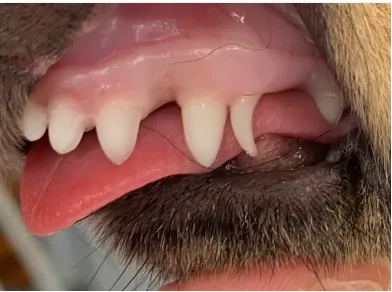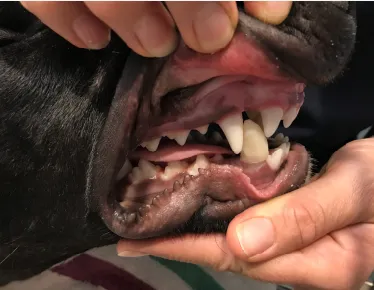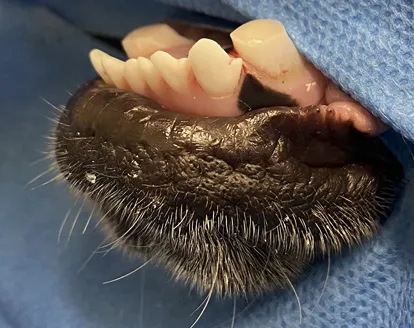
Dentistry Service
Linguoverted Canine Teeth
WAVES HOSPITAL
Linguoverted Canine Teeth
Linguoverted canine teeth, also known as base narrow or inverted canines, are commonly due to skeletal problems, such as a Class 2 malocclusion (overbite), a narrow mandible, or retained deciduous teeth. This is a painful condition and unfortunately, dogs will pretend everything is ok when it isn’t. The mandibular (lower jaw) canine teeth are displaced and strike the soft tissue of the maxilla (upper jaw), causing pain and discomfort. If left untreated the damage to the tissue can be so severe that the canine teeth penetrate the hard palate creating a communication between the mouth and nose (an oronasal fistula).
Depending on the patient’s age, the underlying cause and the position of the teeth will determine how we intervene. A thorough oral examination is required as no two cases are the same.
EXPERTISE & EXPERIENCE
6 – 12 Weeks Old
If the lower deciduous canines are traumatising the soft tissues of the maxilla, we recommend extraction to relieve the patient of this discomfort. Deciduous teeth are very sharp and these puppies are experiencing pain every time they close their mouths. In order to minimise the risk of damaging the developing permanent teeth below the gum line, we recommend dental x-rays and careful extraction.
In a few very lucky cases the permanent teeth erupt in a normal position and no further treatment is required. Unfortunately, in a majority of cases, the permanent teeth will erupt in the same or very similar position and further treatment will be required.
CONTACT OUR TEAM


EXPERTISE & EXPERIENCE
5-6 Months Old
The permanent canine teeth are now starting to erupt. We need to ensure that the deciduous canines are gone and not retained. If the permanent canine is starting to erupt and the deciduous canine is still present we need to extract it as soon as possible otherwise the permanent canine is in the wrong position. Removal of the deciduous canine if done promptly, will allow the permanent canine to move into a more appropriate position.
If the permanent canines are in an unfavourable position, now is the time we can help guide them into a non-traumatic position via external forces. The location of the canines and the severity of the malocclusion will depend on how we intervene. Options include:
- Ball therapy – appropriately sized firm rubber ball played with for 15 minutes three times a day during the eruption period.
- Gingivoplatsy – creating a gingival (gum) ramp to guide the lower canine into the correct position
- Crown extensions – composite is placed on the lower canines to help guide the teeth into a more appropriate position by tipping the canine teeth.
- Selective extractions of minor teeth (usually incisors) – in order to create space for the permanent canines to erupt into.
CONTACT OUR TEAM
EXPERTISE & EXPERIENCE
8 Months Old
If there has been no success with previous interventions or no appropriate treatment options available, then at 8 months of age we can perform a definitive treatment. This is known as crown height reduction and vital pulpotomy. The mandibular canines are reduced in height to the same height as the incisors. Cutting the canines exposes the pulp chamber of the tooth which is then protected with a series of dental restoratives. Patients do require periodic follow-up dental x-rays throughout their lifetime.
For some patients, we can consider an incline plane which is an orthodontic device that is attached to the patient’s upper jaw and helps guide the lower canines into a non-painful position.
Another option available for patients is the extraction of the lower canines. Extraction of the teeth relieves the patient of discomfort and is far better than doing nothing. The benefit of extraction is it does not require long-term follow-up but may result in changes to the appearance of the patient. These changes can include protrusion of the tongue and thinning of the front of the lower jaw. There is a small risk of jaw fracture during extraction.
As you can see there are a variety of different options and this varies for each patient. Regardless of what treatment option we use, improving comfort and quality of life for our patients is always our top priority.
CONTACT OUR TEAM

REGISTRATION
Have a referral?
Have you been referred by a vet? Please complete the registration form.
COMPLETE FORM
Dentistry Services
Endodontics
Linguoverted
Canine Teeth
Maxillofacial
Surgery
Periodontal
Surgery
Restorative
FAQs
OUR DENTISTRY TEAM
Meet Our Dentistry Team
Brace yourself. We are a team like no other. No fill-ins or tooth faries here, just vets who like the tooth, the whole tooth and nothing but the tooth. Our patients can't read our plaques. Molar bears, vampurrs and canines, we'll treat them all. A functional, pain-free mouth for your pet is our floss-ophy. You know the drill.... click on the link and check us out...let's see if we can get to the root of your pet's problems. It might just be love at first bite.
SAY HELLO
DEPARTMENTS
Specialties & Services
CONTACT US
Veterinary Referral & Emergency Services
CONTACT US
